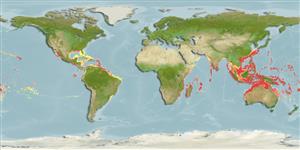Common names from other countries
Classification / Names / Names
आम नाम | उपशब्द | Catalog of Fishes (gen., sp.) | ITIS | CoL | WoRMS
Environment: milieu / climate zone / depth range / distribution range
पारिस्थितिकी
पिलाजिक; गहराई सीमा 0 - 500 m (Ref. 115106). Subtropical; 30°N - 16°N, 100°W - 78°W
Cosmopolitan.
Length at first maturity / आकार / वज़न / Age
Maturity: Lm ? range ? - ? cm Max length : 0.8 cm BL पुल्लिंग / अलिंग; (Ref. 3682)
Maximum depth from Ref. 83943. This is an oceanic epiplanktonic species (Ref. 3702). Particularly found in epipelagic and mesopelagic depths (Ref. 83943). Also neritic (Ref. 116105). Chaetognaths are active carnivores, feeding mostly on copepods, crustacean larvae and other chaetognaths, and occasionally on forams and fish larvae (Ref. 81541).
Life cycle and mating behavior
परिपक्व अवधि | पुनरुत्पत्ति | मछलीऔ का अंडे देना | अंडे | Fecundity | लार्वा
Members of the phylum Chaetognatha are hermaphroditic. Mating behavior: A preliminary visual signaling behavior for species recognition is observed to prevent predation. Life cycle: Eggs directly develop into miniature adults (hatchlings).
Pierrot-Bultz, A. 2004. (Ref. 3682)
IUCN Red List Status (Ref. 130435)
CITES status (Ref. 108899)
Not Evaluated
Not Evaluated
Human uses
| FishSource |
साधन
अधिक जानकारी
Age/Sizeबाढ़Length-weightLength-lengthआकृति विज्ञानलार्वाबहुतायत
इंटरनेट स्रोत
Estimates based on models
Preferred temperature
(Ref.
115969): 13.3 - 26.4, mean 19.7 (based on 501 cells).
Vulnerability
Low vulnerability (10 of 100).
Price category
Unknown.
